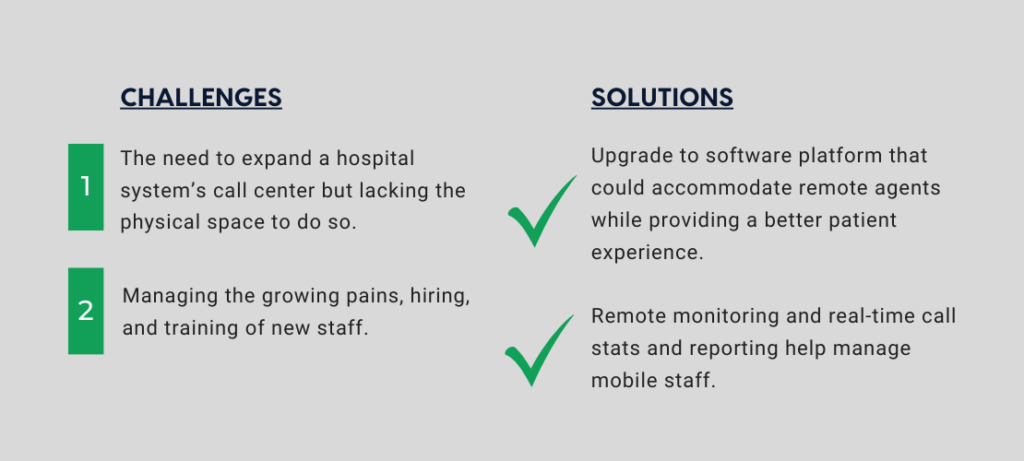For some hospitals, having enough space to operate efficiently is an issue. One of the most significant advantages of a cloud-enabled contact center platform is that it allows operators to work from home, making the space otherwise taken up by an on-site call center available for other uses.
A Midwestern hospital was faced with the issue of wanting to expand but not wishing to reconstruct its facilities. The hospital call center manager commented, “One of the biggest issues for us is that they built this hospital not knowing it would expand as fast as it did. We have a huge space issue here.”
The hospital’s transcriptionists already worked from home. Their ability to work remotely made the call center manager wonder if her department could have the same capabilities. She continued, “When we were looking at software for our call center, one of the things we wanted was to be able to have our agents work from home. Our space is just so tight in all of our facilities.”
“The number of caller complaints have dropped drastically since switching to Amtelco’s call center software.”
Call Center Manager
Ensuring Staff Safety
Before deciding on the operators’ new location, the hospital looked into other possibilities. “We had the option of moving to other locations, but because there was only someone there during the day, the staff felt unsafe. We also looked at another one of our facilities, but that location couldn’t handle the call volume,” said the manager.
It was determined that working from home would be the best and safest option for the operators, especially during the night hours.

Selecting the Right Staff
Each operator’s annual performance reviews were analyzed before deciding who would be offered the remote operator positions. These evaluations included technical components that looked at the operator’s job competencies, such as how well they could handle emergency calls, perform paging and overhead paging functions, handle calls from physicians and patients, and differentiate between routine calls and emergency calls.
The hospital also reviewed behavioral competencies, which included the operator’s commitment to service, quality of service, productivity, and teamwork skills. Each operator’s call volume, length of time spent on calls, and how often they logged in and out.
Preliminary Testing
Great care was taken when implementing remote staff. After selecting which operators would work from home, the manager and another staff member tested the remote operator stations for about a month. This helped to determine exactly what the operators would be experiencing from home. The manager commented, “Once we knew our new remote arrangement would work, we gave the operators home computers to use, and we were able to get them up and running. I gradually added more remote agents.”
Home Setup
For this particular Midwestern hospital, 16 operators are working from home. Each agent was given a computer, a phone, and Internet access to handle calls.
Before working remotely, each operator was required to sign an agreement that included things such as eliminating background noise, requirements to report to the hospital in case of a cable or power outage, attending staff meetings, returning equipment immediately upon leaving, providing an appropriate work area for themselves, and bringing equipment in for upgrades or repairs. Many operators designated a room in their home for handling calls to help eliminate background noise and to help them stay focused.
Even though the operators are 20 or 30 miles away, it’s like they are sitting in the building. Remote agents can handle all types of calls, including code calls and overhead pages—all as if they were on-site.

Keeping Operators Updated
The operators use Amtelco’s chat feature to keep other updated, for example, to inform the other operators to contact a doctor on her cell phone, not her pager. The chat feature enables them to communicate as if they are in the same room.
Improved Caller Satisfaction
When working on-site, the operators typically worked eight-hour shifts. However, after reviewing reports about wait times and dropped calls during lunch breaks and regular busy times, it was determined that operators working from home could better meet the hospital’s call-handling needs. As a result, remote agents enjoyed more flexible schedules, and the call center could offer better service to their callers.
The Benefits of Working from Home
One obvious benefit from the beginning was the reduced operator sick days. “Between sick calls and having to travel in bad weather, we don’t get as many absences as we used to. And if we get a sick call from somebody, finding someone to fill in is easier.”
Having the operators work from home has also opened up a sizeable potential employee pool, including those unable to travel to the central location.
Working from home offers operators other benefits. “They don’t have to pay for gas, they don’t have wear-and-tear on their vehicles, and they don’t have the clothing expense. When agents start their day, they log into our timecard and don’t have the commuting time. Because of the economy, there are some benefits we can’t give to them, but I think some of these perks help alleviate that,” stated the hospital manager.
“The new hires work with a seasoned operator, listen for a day or two, and then usually by the third day, they are taking calls.”
Call Center Manager
Simplified Training and Remote Monitoring
When new operators are hired, they typically train on-site for a month. “The new hires work with a seasoned operator, listen for a day or two, and then usually by the third day, they are taking calls. They’ll start by taking calls from one specific site and then move on to handle calls from all of our sites and more complex calls as they progress with their learning. They work with the veteran operator to ensure all is going well,” according to the manager.
Agents who work from home can be monitored remotely. “The minute I walk in the building, I turn my agent screen on, and I chat with the operators to make sure they’re okay,” said the manager. “I run reports to ensure call quality and work performance.” Calls and call recordings can be monitored daily to assess the operator’s ability to handle calls correctly. She continued, “The number of caller complaints have dropped drastically since using Amtelco’s software.”
Keeping Staff Connected
One thing many operators miss about not being in the office daily is the social aspect. To help keep people connected, in-person staff meetings are scheduled every three weeks. The operators also plan additional staff outings outside of work and meet with each other for lunch on their days off.
Backup Plan
Suppose Internet or phone service goes out or operators cannot use stations remotely. In that case, the operators must report to the main hospital facility, where backup stations are available. The manager commented, “I have people located in two different counties. The last time we lost our Internet service, we discovered that everyone in one county experienced an outage, but the people in the other county were okay. I had the backup, so I could call the operators in the available county and ask them to hop on the phones.”
As this Midwestern hospital continues to grow, more staff members are working from home to save space at their facility.



